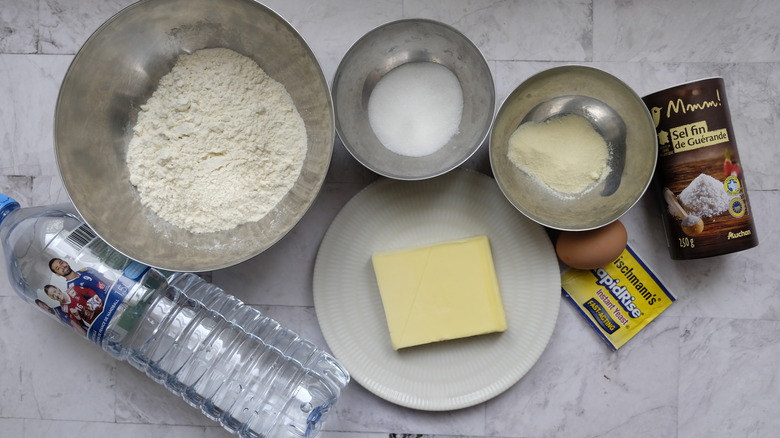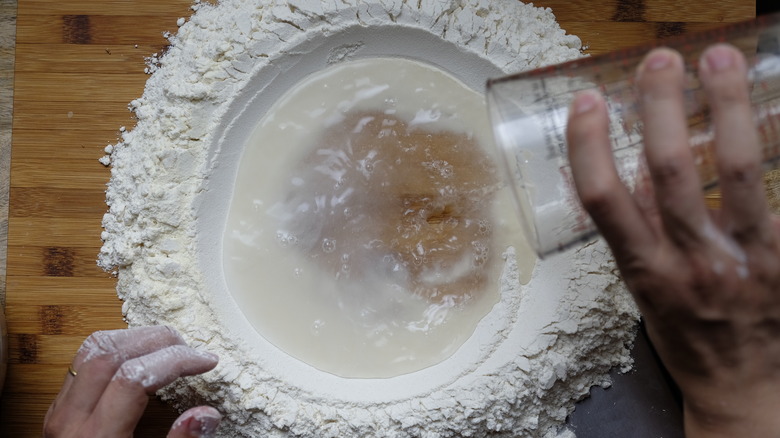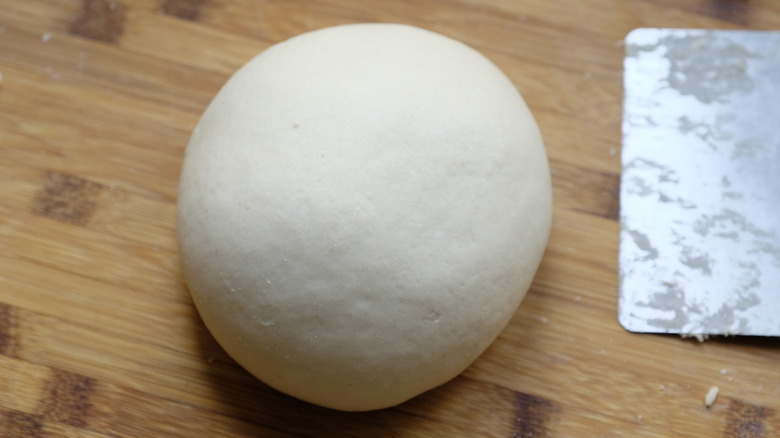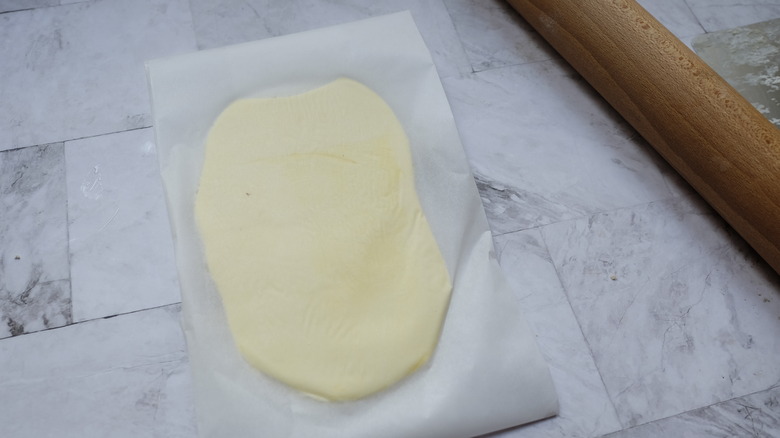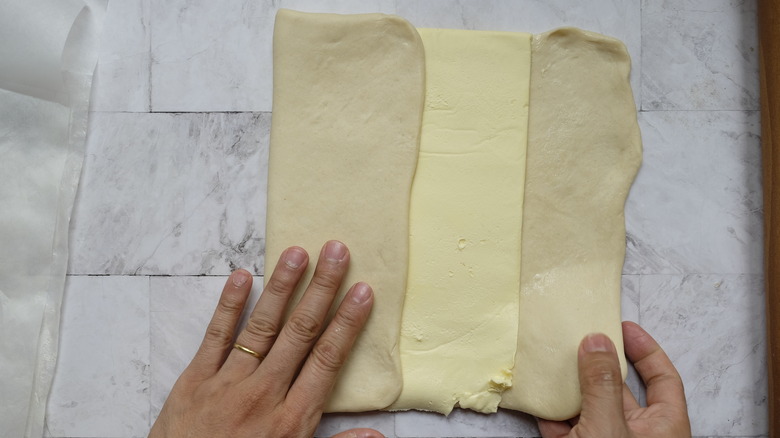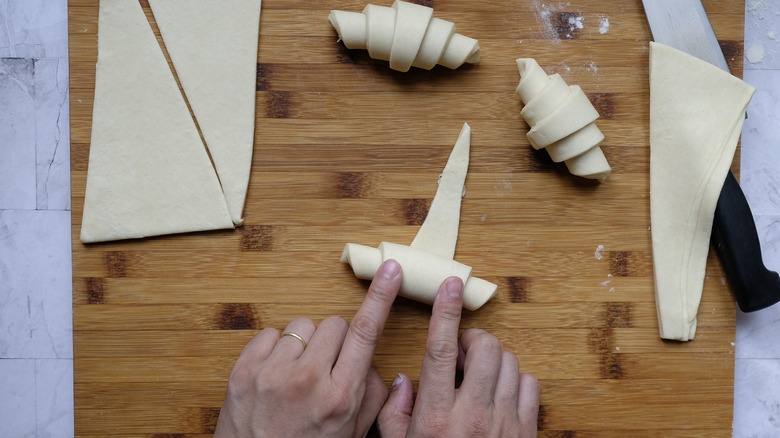Definitive Classic Butter Croissant Recipe
The world of French pastries is a juxtaposition between delicate treats and the elaborate efforts required to produce them. Consider the croissant: It's light and flaky (though simultaneously buttery rich) and it requires multiple steps. Before you become intimidated and decide to stop by the local bakery instead, just think about the level of accomplishment you'll feel as you bite into the timeless pastry created with your own two hands.
As a pastry instructor in Paris, Food Republic recipe developer Eric Ngo knows a thing or two about croissants. Ngo describes this definitive classic butter croissant as "a foundational recipe," adding that "once you master this, you can change the shape you cut, resulting in different pastries such as chocolate croissants, aka pain au chocolate, or even make New York rolls." Basically, if you can make croissants, then anything is possible. This recipe requires time since you will need to refrigerate the dough at multiple stages. Aside from that, the ingredients are straightforward which makes this a good baking project for a rainy weekend.
Gather the ingredients for this definitive classic butter croissant recipe
For this recipe, you'll need flour, salt, sugar, instant yeast, evaporated milk powder, water, European-style unsalted butter, and an egg. While standard butter won't entirely ruin the croissants, it will make the process a little trickier. Ngo recommends butter with a fat content of 82%, which prevents it from melting too quickly while you work on the dough.
Start by combining the dough ingredients
Grab a large bowl and dump in the flour, sugar, salt, and evaporated milk powder. Mix the ingredients with a spatula or your hands to distribute them evenly. Empty out the mixture onto a clean flat work surface. Make a well in the center — use the bottom of the bowl to assist you.
Carefully pour the water into the middle and add the instant yeast. Use your fingers to swirl the mixture and dissolve the yeast. Then, move the flour toward the middle a bit at a time with your fingers. Continue to push the flour into the wet ingredients until everything is combined.
Knead the croissant dough and let it rest
Now, knead the dough to build up the gluten, giving it a stretchy and unified texture. Keep going until the dough is smooth and no longer sticky. You can test it by seeing if it bounces back when you press into it.
Shape the dough into a ball and use a damp tea towel or plastic wrap to cover it. Leave it at room temperature (68 to 70 F) for half an hour, then press the ball to shape it into a flat rectangle. Store it first in the freezer for 1 hour, then transfer it to the refrigerator for another 6 hours (or overnight, if you prefer).
Roll out the dough a couple of times
If you're a regular baker, you've probably used a rolling pin before. Still, it's worth incorporating Ngo's tips for optimal results, as he points out, "The most important step or skill is knowing how to use the rolling pin effectively." Specifically, he explains, "The more efficient you are with rolling, the quicker you'll be, and thus the butter will less likely melt, resulting in a better layering."
On the other hand, melted butter "will result in a very dense croissant" — not really what comes to mind when you think of the airy pastry. Another way he prevents this outcome is by making use of the refrigerator and freezer. Ngo advises, "As soon as you feel like the butter is melting, stop working, and let it get back to a cold and flexible texture."
Now that you understand the why, let's break down the what. Take the butter and fold it between a piece of parchment paper. Roll it out until you have a rectangle measuring 8x6 inches, then pop it into the fridge until it's time to use it. Next, roll out the dough onto a clean surface to make a 12 x 16-inch rectangle. If it starts to get sticky, simply dust it lightly with flour.
Incorporate the butter and roll the dough again
Retrieve the butter from the fridge (it should be cold and flexible) and place it in the middle of the dough rectangle. Fold either side of the dough toward the middle to close it like a book. Lightly sprinkle the top and bottom of the dough with flour and roll it out until the dimensions are 24 x 8 inches. Follow with a book fold — fold ¾ of one side toward the center, fold the remaining ¼ to close, and then fold the rectangle over itself — which is akin to laminating the dough. Wrap the dough in plastic and transfer it to the refrigerator for half an hour.
After 30 minutes, sprinkle your counter with flour and repeat the process of rolling the dough to a 24 x 8-inch rectangle. Then, fold it once, wrap it in plastic, and store it in the fridge for 30 minutes. This is where patience and an open schedule are essential.
Shape the croissants and proof
Now, roll out the dough into a 20 x 7 inch rectangle that is about 0.1 inches in thickness. Slice the dough into six isosceles triangles (two equal-length sides and a short side). Starting with the shorter side, roll the dough into a croissant.
If you want to satisfy a future craving for croissants, this is a good place to stop. Ngo says to freeze the rolled croissants and "simply take them out of the freezer the night before." Then, you should place them on a baking sheet and let the dough slowly rise in an unheated oven for 6 to 7 hours before brushing the croissants with the egg wash and baking.
If you're working in real-time, line a baking sheet with parchment paper and evenly space out the rolled croissants. Whisk the egg in a small bowl and brush the croissants with the egg wash. Set your oven to proof between 77 and 82 F. Transfer the baking tray to a rack along with a bowl of hot water and proof the dough for 2 hours.
Bake the croissants then serve
Once the dough is proofed, remove the tray and preheat the oven to 350 F. Add an extra coating of egg wash and bake the croissants for 18 minutes until golden. Serve them warm out of the oven with a café au lait for arguably the best way to start your day.
In case you end up with a few extras, try making an apple croissant bread pudding, or serve your egg salad sandwich on a flaky croissant.
Definitive Classic Butter Croissant Recipe
You won't feel daunted by making your own classic butter croissants at home when you follow this definitive recipe.

Ingredients
- 1 cup flour
- 2 teaspoons salt
- 2 tablespoons sugar
- ¾ teaspoon instant yeast
- 1 tablespoon evaporated milk powder
- ½ cup water
- 1 ¼ stick European style unsalted butter
- 1 egg, whisked
Directions
- In a large bowl, mix the flour, sugar, salt, and milk powder together with a spatula or your fingers.
- Pour the mixture onto a workbench and make a well using the bowl.
- Add water and instant yeast in the middle and mix with your fingers until the yeast dissolves.
- Bring the flour little by little toward the middle with your fingertips, mixing until all of the flour is incorporated.
- Knead the dough until it is smooth. It should no longer be sticky and should bounce back when gently pressed.
- Cover the dough with a damp tea towel or plastic wrap and let it rest at room temperature (68 to 70 F) for 30 minutes.
- Press the dough down and shape it into a flat rectangle, then store it in the freezer for 1 hour, followed by a minimum of 6 hours in the refrigerator.
- In between a piece of parchment paper, roll out the butter until it is 8 x 6 inches.
- Store it in the refrigerator until ready to use and the texture is cold and flexible.
- Roll out the dough into a rectangular shape measuring 16 x 12 inches and dust it with flour to prevent it from sticking to the workbench.
- Place the cold butter in the center of the dough and fold the dough toward the middle.
- Dust the top and bottom of the dough with flour and roll it into a 24 x 8-inch rectangle.
- Proceed with a book fold (aka a double fold, as if you are folding a book closed twice).
- Wrap the dough with plastic wrap and store it in the refrigerator for 30 minutes.
- Dust the counter with flour and roll out the dough once again to 24 x 8 inches and proceed with a simple fold.
- Wrap it with plastic wrap and store it in the refrigerator for another 30 minutes.
- Now, roll out the dough into a rectangle about 0.1 inches thick, 20 inches long, and 7 inches wide.
- Cut the dough into six isosceles triangles and roll them into croissants.
- Place the croissants on a baking sheet lined with parchment paper.
- Whisk the egg and brush the croissants with the egg wash.
- Transfer the tray to the oven with a bowl of hot water and proof for 2 hours at a temperature between 77 and 82 F.
- Take the croissants out of the oven and preheat it to 350 F.
- Apply a second layer of egg wash and bake the croissants for 18 minutes.
- Serve warm.
Nutrition
| Calories per Serving | 279 |
| Total Fat | 20.4 g |
| Saturated Fat | 12.4 g |
| Trans Fat | 0.0 g |
| Cholesterol | 78.6 mg |
| Total Carbohydrates | 20.8 g |
| Dietary Fiber | 0.7 g |
| Total Sugars | 4.8 g |
| Sodium | 179.7 mg |
| Protein | 3.8 g |


